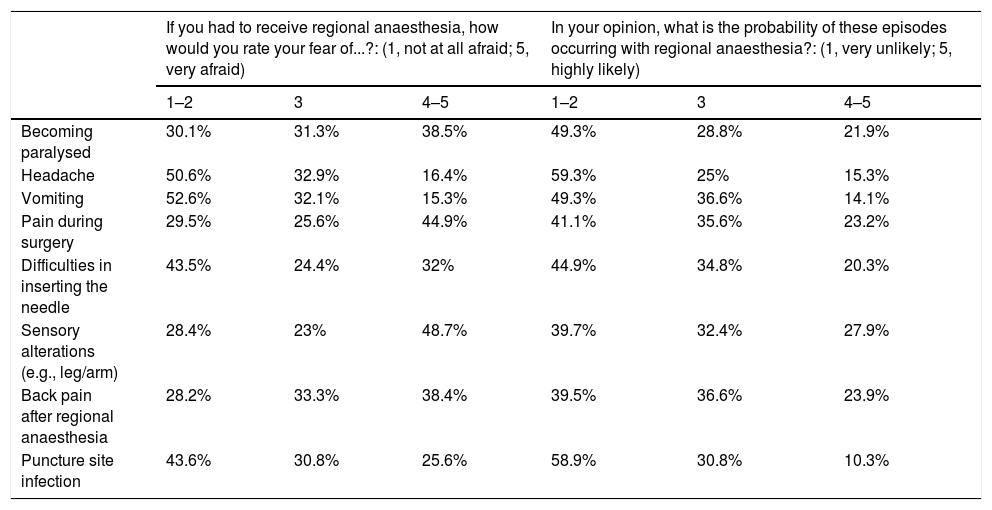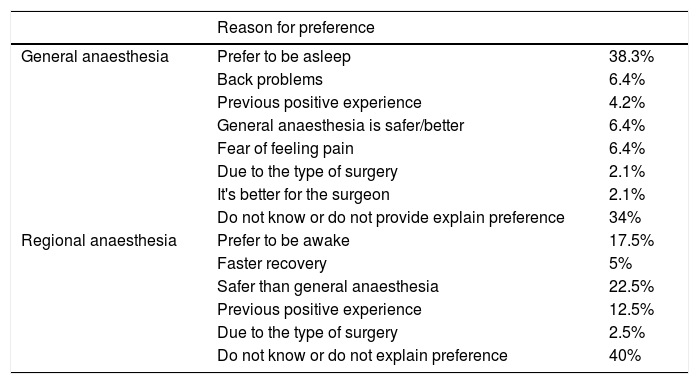Regional anaesthesia (RA) has gained popularity due to its numerous benefits and increasing safety. Yet, often patients refuse this procedure and prefer general anaesthesia (GA). This study aimed to investigate variables (demographic factors, safety perception of GA and RA, patients’ fears, anxiety, and knowledge) related to patients’ anaesthetic preference.
Material and methodsParticipants were patients aged 18 years or more proposed to an anaesthesia appointment for preoperative assessment. Patients completed a written questionnaire before meeting the anaesthesiologist. The questionnaire asked about their preferences, fears and perceptions about RA.
ResultsOne hundred and 2 patients agreed to participate. Mean age was 52.6±13.5 years, 57.8% were female and 44.5% had at least 12 years of education. Given the choice, 54.0% would prefer GA and 20.7% said they would refuse RA if proposed by the anaesthesiologist. Among patients who already experienced neuroaxial anaesthesia, 40.0% said they did not wish to repeat it. Patients who preferred GA over RA perceived GA to be safer than RA and expressed more anxiety towards being awake during surgery and more fear of feeling pain during surgery, of having back pain, and of needle puncture. Results also suggested that patients are unaware of RA's real risks and benefits.
ConclusionsKnowing patients’ fears is essential for the anaesthesiologist address their patients’ needs. Anaesthesiologists should work on improving general population perspective and knowledge about RA.
La anestesia regional (AR) ha ganado popularidad debido a sus beneficios y su seguridad. Sin embargo, muchos pacientes rechazan la AR en favor de la anestesia general (AG). Este estudio investiga las variables (factores demográficos, percepción de seguridad, miedos y conocimientos sobre la AR) relacionadas con las preferencias anestésicas de los pacientes.
Material y métodosLos participantes eran mayores de 18 años, propuestos para una consulta anestésica. Rellenaron un cuestionario previamente a su cita.
ResultadosCiento dos pacientes accedieron a participar. La media de edad era de 52,6±13,5 años. El 57,8% eran mujeres y el 44,5% contaba al menos con 12 años de estudios. Dados a elegir, el 54% prefería AG y el 20,7% rechazaba AR en caso de que se lo propusiera el anestesiólogo. Entre los pacientes que ya habían experimentado anestesia neuroaxial, el 40% no quería repetirlo. Los pacientes que preferían AG en lugar de AR la percibían como más segura y expresaban mayor ansiedad por permanecer despiertos durante la cirugía. Estos fueron también los que tenían mayor temor al pinchazo, al dolor de espalda y a sentir dolor durante la cirugía. Los resultados indican que los pacientes no conocían los verdaderos riesgos y beneficios de la AR.
ConclusionesEl conocimiento de los temores de los pacientes es esencial y ayudará a los anestesiólogos a satisfacer las necesidades de sus pacientes. Los anestesiólogos deben esforzarse en mejorar las perspectivas de la población y su conocimiento sobre la RA.
Artículo
Comprando el artículo el PDF del mismo podrá ser descargado
Precio 19,34 €
Comprar ahora










